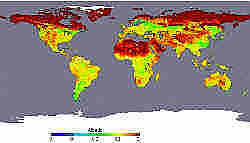Measuring earthshine: How new terra data are improving weather and climate forecast models

<a href=http://www.gsfc.nasa.gov/gsfc/earth/pictures/20020624earthshine/modis_albedo_anim_sm.mpeg><b>A N I M A T I O N</b></a>
A sensor aboard NASA’s Terra satellite is helping scientists map how much sunlight the Earth’s surface reflects back up into the atmosphere, and this new detailed information should help to greatly improve weather and forecast models. The Moderate Resolution Imaging Spectroradiometer (MODIS) now routinely provides daily global and local measurements of albedo, or the total amount of light reflected from Earth’s surface out to space. These precise data may allow scientists to better understand and predict how various surface features absorb and reflect solar radiation, which influence both short-term weather patterns and longer-term climate trends.
In a May 2002 issue of Geophysical Research Letters, a team of scientists at Boston University reported that the new albedo measurements match up well with the wide variance of geological features found across the Earth’s barren landscapes.
“Zooming in on Africa’s Sahara Desert and the Arabian Peninsula, for instance, MODIS observed considerable variability in reflectance across the region-from the darkest volcanic terrains to the brightest sand sheets,” said Elena Tsvetsinskaya, the paper’s lead author and a researcher at Boston University. “So we can relate specific soil groups and rock types to MODIS-derived albedo measurements.”
This correlation is important because most current weather forecast models treat this region as if the surface is uniform and therefore reflects the same amount of light all across its wide expanse. However, the terrain across the Sahara Desert and Arabian Peninsula is actually quite varied. Darker surface features (like rocks and plant canopies) absorb more light than lighter surfaces (like sand) and therefore get hotter in the afternoon. Over the course of a day, these heating differences can set up atmospheric motions that influence clouds and rain.
By coupling the MODIS measurements with geologic information, Tsvetsinskaya and her colleagues have provided weather and climate modelers with a new map of albedo across Northern Africa and the Arabian Peninsula that they can use to fine-tune their models. The team classified the region into eight categories, each of which has a distinct reflectivity range.
“There is a certain scientific beauty in deriving albedos from something else in the model (such as geologic information),” said Robert Dickinson, project lead at the Georgia Institute of Technology. “But the more practical reason is for ’what if’ studies. For example, what if the wind in Africa blew so hard it covered all the black rocks with white sand?”
This scenario hints at what both meteorologists and climate researchers alike know well: albedo for a given region can change relatively quickly. For example, the bright white snow- and ice-covered landscapes of Canada and Siberia during the winter and early spring reflect most incoming solar radiation back up into space, thereby helping to keep the surface cold.
But as the snow melts with the gradual onset of summer, the boreal forest canopy is exposed to the sunlight. The vegetated surface is much darker and strongly absorbs light, which helps to warm the surface.
NASA scientists discovered recently that once the snow melts in the Earth’s boreal regions, densely-vegetated surfaces begin to release a significant amount of heat into the overlying atmosphere. Yufang Jin, a Boston University graduate student, uses MODIS albedo data to document the difference between snow covered and snow-free vegetated surfaces in a related paper in another May issue of Geophysical Research Letters.
Over the longer term, regular MODIS albedo measurements will allow scientists to monitor how the Earth’s reflectivity changes on a global scale. “This will help us determine how the Earth’s climate is changing, both globally and locally,” said Crystal Schaaf, co-author and research professor at Boston University. “When humans convert a vegetated region to a more reflective surface type (such as an urban area), the albedo changes.”
Similarly, Schaaf added, when places like the grasslands of the African Sahel contract, they leave more reflective, barren deserts, which increases albedo.
###
Launched December 18, 1999, Terra is the flagship of the Earth Observing System series of satellites and a central part of NASA’s Earth Science Enterprise. The mission of the Earth Science Enterprise is to develop a scientific understanding of the Earth system and its response to natural and human-induced changes to enable improved prediction capability for climate, weather, and natural hazards.
For more information and images: http://www.gsfc.nasa.gov/topstory/20020624earthshine.html
Media Contact
All latest news from the category: Earth Sciences
Earth Sciences (also referred to as Geosciences), which deals with basic issues surrounding our planet, plays a vital role in the area of energy and raw materials supply.
Earth Sciences comprises subjects such as geology, geography, geological informatics, paleontology, mineralogy, petrography, crystallography, geophysics, geodesy, glaciology, cartography, photogrammetry, meteorology and seismology, early-warning systems, earthquake research and polar research.
Newest articles

First-of-its-kind study uses remote sensing to monitor plastic debris in rivers and lakes
Remote sensing creates a cost-effective solution to monitoring plastic pollution. A first-of-its-kind study from researchers at the University of Minnesota Twin Cities shows how remote sensing can help monitor and…

Laser-based artificial neuron mimics nerve cell functions at lightning speed
With a processing speed a billion times faster than nature, chip-based laser neuron could help advance AI tasks such as pattern recognition and sequence prediction. Researchers have developed a laser-based…

Optimising the processing of plastic waste
Just one look in the yellow bin reveals a colourful jumble of different types of plastic. However, the purer and more uniform plastic waste is, the easier it is to…



